Bahrain B2B Marketplaces Market Outlook to 2030
By Buyer Industry, By Marketplace Model, By Buyer Size, By Payment Method, and By Fulfillment Mode
- Product Code: TDR0234
- Region: Middle East
- Published on: August 2025
- Total Pages: 110
Introducing the World's FirstPay-Per-Section Market Reports
Why pay for the full report when you need just a part?
Start Building Your Report
Scroll down to see available sections
Report Summary
The report titled “Bahrain B2B Marketplaces Market Outlook to 2030 – By Buyer Industry, By Marketplace Model, By Buyer Size, By Payment Method, and By Fulfillment Mode” provides a comprehensive analysis of the B2B digital trade ecosystem in Bahrain. The report covers the overview and genesis of the industry, overall market size in terms of gross merchandise value and platform revenues, market segmentation, emerging trends and developments, regulatory and compliance landscape, buyer and seller profiling, key issues and challenges, and competitive landscape including competition scenario, cross-comparison, opportunities and bottlenecks, and company profiling of major marketplace operators. The report concludes with future market projections based on transaction volumes, category growth, payment innovations, regulatory reforms, and success case studies highlighting the major opportunities and risks shaping the Bahrain B2B marketplaces sector.
Bahrain B2B Marketplaces Market Overview and Size
The Bahrain e‑commerce market is valued at USD 412 million, derived from actual industry data reflecting its full scope—including B2B and B2C transactions—based on 2024 figures. This figure encompasses robust digital commerce activity, underpinned by accelerated internet adoption, smartphone penetration, and targeted digital infrastructure investments by the government. Expansion in fintech (e-cheques, open banking) and logistics enhancements have particularly propelled B2B platform activity.
Bahrain’s capital and its surrounding governorates dominate the B2B marketplaces market due to dense commercial clusters, proximity to key free-zones like Bahrain Logistics Zone and Khalifa Bin Salman Port, and concentration of large corporates, SMEs, and state entities. The Central Governorate, with its higher industrial and governmental procurement activity, further fuels marketplace usage. Cross-GCC traders also use Bahrain as a gateway due to preferential trade agreements and streamlined customs frameworks.
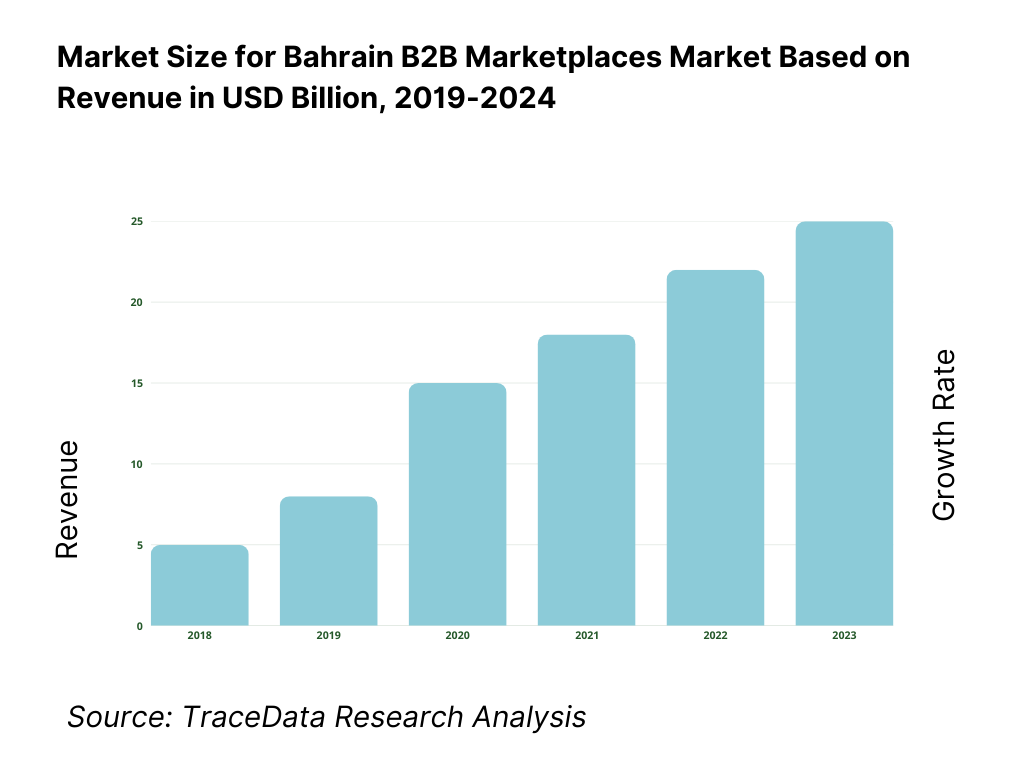
What Factors are Leading to the Growth of the Bahrain B2B Marketplaces Market:
Surge in Digital Connectivity: Bahrain now boasts 100% internet penetration, with approximately 1.48 million internet users, reflecting digital readiness essential for online B2B interactions. Mobile infrastructure is equally robust—with 2.10 million cellular mobile connections, equating to 142% of the population. This saturation ensures seamless access for businesses across buyers, sellers, logistics partners, and regulators to interact via digital platforms. The high availability of broadband and mobile connectivity reduces friction in marketplace transactions, laying a resilient foundation for B2B platforms to scale.
Open Trade Orientation and Export-Import Activity: Bahrain’s economy is deeply integrated with global trade, with foreign trade (exports plus imports) accounting for approximately 158% of GDP, indicating a dense web of cross-border flows critical for B2B sellers and logistic facilitators. In Q1 of the most recent year, total exports increased by 8%, signaling growth in outbound trade volumes that B2B marketplaces can capture. A current account surplus of 5.86% of GDP underscores healthy net trade and inbound capital flows. Together, these figures underscore that robust trade activity and economic openness stimulate demand for digital procurement and cross-border connectivity.
High GDP Per Capita & Service Sector Dominance: Bahrain’s nominal GDP stands at USD 47.8 billion, with a per capita nominal income of approximately USD 29,600, highlighting strong purchasing power among enterprises. The services sector contributes around 51% of GDP, while industry adds 44%, demonstrating demand across a range of B2B categories—from industrial supplies to services and trading platforms. Elevated income levels enable businesses to invest in digital transformation, and strong industrial-service integration creates both supply and demand for efficient marketplace solutions.
Which Industry Challenges Have Impacted the Growth of the Bahrain B2B Marketplaces Market:
High Public Debt Burden: Bahrain’s sovereign debt has climbed to 123% of GDP in the latest year, potentially constraining government-led support for digital infrastructure or fintech subsidies that benefit marketplace ecosystems. Elevated debt levels may force fiscal tightening, limiting investments in enabling infrastructure or dampening demand from cost-conscious public institutions and SMEs. High leverage can also lead to currency risk or financial instability, which can deter longer-term buyer-seller contracts.
Export-Dependency & Commodity Volatility: Although trade is robust, Bahrain relies heavily on oil and aluminum exports, with petroleum accounting for around 60% of export receipts, 70% of government revenues, and roughly 11% of GDP. This export concentration exposes B2B marketplace demand to commodity price fluctuations—periods of lower oil prices can lead to slower investment from upstream industries (e.g., construction, industrial procurement) that drive marketplace volume.
Need for Strong Data Protection Infrastructure: While connectivity is high, widespread digital adoption brings elevated risks around data privacy and cybersecurity. Bahrain’s regulatory framework (e.g., PDPL, e‑invoicing, digital ID) must evolve to meet platform and enterprise expectations. The World Bank emphasizes that inclusive digital systems must include trustworthy digital identity frameworks, secure payments, and data protection laws. Any lag in implementing these standards could erode user trust and inhibit B2B platform scaling.
What are the Regulations and Initiatives which have Governed the Market:
Electronic Transactions & E-Signature Law: The Government of Bahrain has mandated the use of secure electronic signatures and legally recognized digital contracts for online platforms under the Electronic Transactions Law. This regulation ensures trust and enforceability of B2B contracts executed via digital marketplaces. In 2023, Bahrain ranked first in MENA for digital transactions readiness, reflecting the success of these measures in creating a secure environment for marketplace activity.
VAT Implementation & Compliance Requirements: Bahrain introduced a 10% Value Added Tax (VAT) regime applicable to goods and services, including digital marketplace transactions. Marketplaces facilitating procurement are required to register with the National Bureau for Revenue (NBR) and file monthly or quarterly VAT returns. In 2023, VAT revenues in Bahrain reached BHD 350 million, underscoring the role of regulated transactions in government fiscal policy. This VAT framework enforces transparency and accountability for B2B platforms.
Personal Data Protection Law (PDPL): Bahrain enacted its Personal Data Protection Law to govern how digital platforms collect, process, and transfer business and personal data. Marketplaces must obtain consent, safeguard buyer-seller data, and comply with cross-border data transfer restrictions. In 2022, over 1.5 million internet users in Bahrain were covered under PDPL, creating a regulated environment that ensures data privacy and strengthens buyer trust. Enforcement of PDPL has made compliance a critical requirement for B2B platforms operating in Bahrain.
Bahrain B2B Marketplaces Market Segmentation
By Buyer Industry: Among industry verticals, Industrial & Manufacturing leads due to high-value procurement cycles, recurring MRO requirements, and structured supply chains that align well with digital marketplaces. Bahrain’s role as a regional manufacturing and distribution hub, especially for GCC-bound exports, elevates demand for streamlined, digital procurement, reinforcing this vertical's prominence.
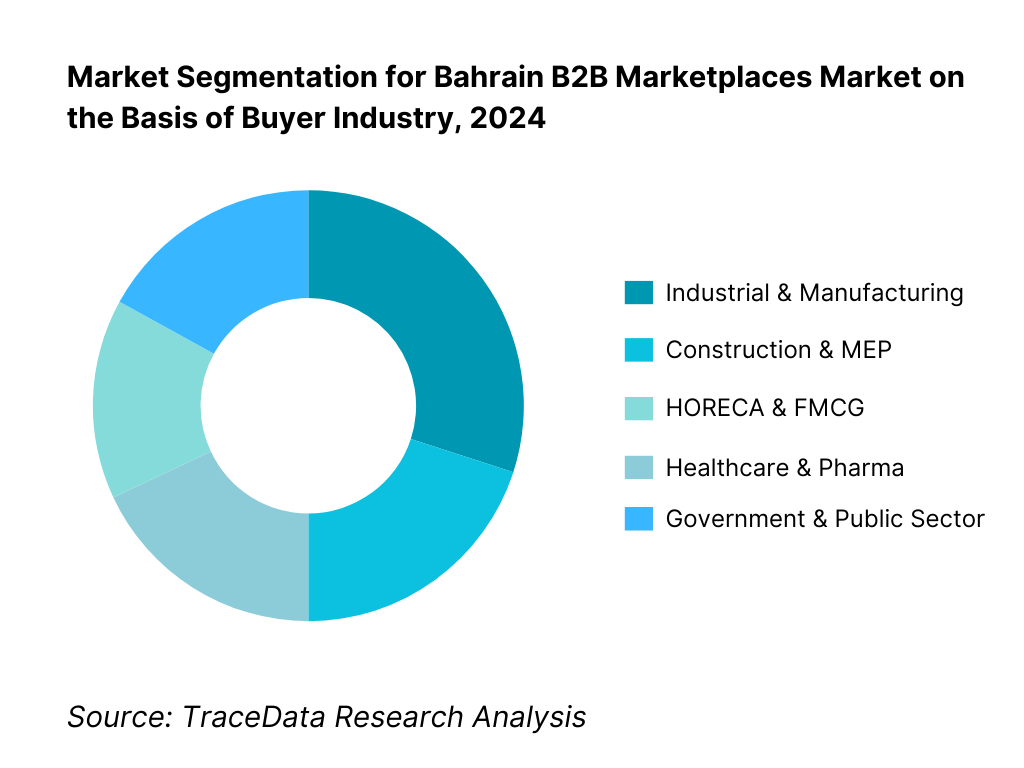
By Marketplace Model: Vertical marketplaces lead due to tailored offerings—such as industrial MRO parts, construction materials, or healthcare supplies—that directly match buyer requirements. Category specificity improves supplier curation, catalog depth, and trust, leading to higher repeat usage by industry buyers. Bahrain’s arena, with regulatory oversight and industry clusters, favors such specialized platforms.
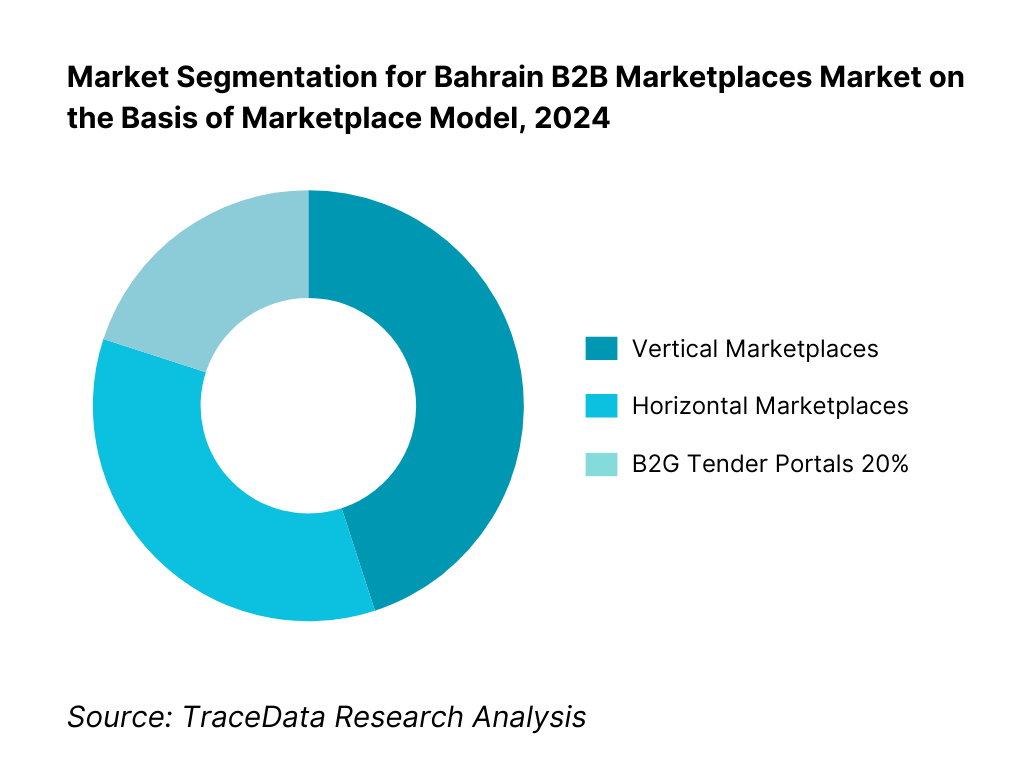
Competitive Landscape in Bahrain B2B Marketplaces Market
The Bahrain B2B marketplaces market displays moderate fragmentation, with a handful of specialized vertical platforms (Industrial, HORECA, Pharma), regional giants facilitating cross-border trade, and a strong tilt toward platforms enabling government tendering. Traditional distributors and importers are also increasingly adopting digital interfaces.
Name / Platform | Founding Year | Headquarters |
Tradeling | 2020 | Dubai, UAE |
Alibaba.com | 1999 | Hangzhou, China |
Global Sources | 1971 | Hong Kong, China |
Made-in-China.com | 1998 | Nanjing, China |
TradeKey Bahrain | 2005 | Karachi, Pakistan |
ExportHub Bahrain | 2017 | Houston, USA |
SupplyVan (Industrial/MRO) | 2016 | Dubai, UAE |
MawadOnline (Construction Materials) | 2021 | Dubai, UAE |
JomlahBazar (Wholesale FMCG) | 2018 | Dubai, UAE |
Aumet (Healthcare & Pharma) | 2016 | Amman, Jordan |
Retailo (FMCG Distribution) | 2020 | Riyadh, Saudi Arabia |
Sary (FMCG Wholesale) | 2018 | Riyadh, Saudi Arabia |
DUBUY.com by DP World | 2021 | Dubai, UAE |
Plant & Equipment (Heavy Equipment) | 2000 | Dubai, UAE |
Bahrain Tender Board e-Tendering Portal | 2002 | Manama, Bahrain |
Some of the Recent Competitor Trends and Key Information About Competitors Include:
Tradeling: As one of the fastest-growing B2B marketplaces in the GCC, Tradeling has expanded its seller base across industrial and FMCG categories. In 2024, it reported a significant increase in cross-border transactions from Bahrain, driven by partnerships with local distributors and logistics providers.
Alibaba.com: A global leader in B2B e-commerce, Alibaba.com has strengthened its Bahrain operations by onboarding SMEs into its international export program. Recent initiatives have included localized support for customs documentation and trade financing, making it easier for Bahraini businesses to access global buyers.
MawadOnline: Specializing in construction materials, MawadOnline has expanded into Bahrain’s construction sector by partnering with major contractors. The platform has integrated advanced logistics tracking in 2024, helping local buyers reduce procurement lead times.
Retailo: Focused on FMCG and HORECA supply, Retailo has seen strong adoption among Bahrain’s small retailers. In 2024, the company introduced flexible payment solutions, including BNPL (Buy Now Pay Later), to support liquidity-constrained SMEs in the country.
Aumet: A leading healthcare and pharma B2B platform, Aumet has expanded its Bahrain operations through alliances with pharmaceutical distributors. In 2024, it launched a compliance-driven procurement module to meet Bahrain’s regulatory requirements in the healthcare supply chain.
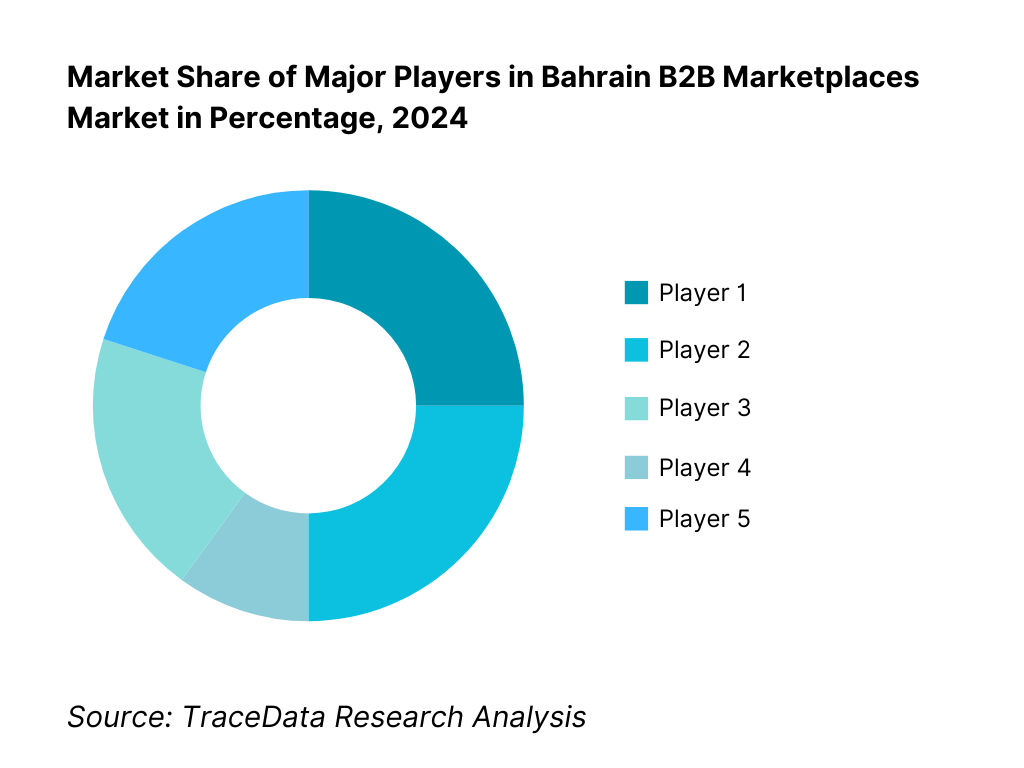
What Lies Ahead for Bahrain B2B Marketplaces Market?
The Bahrain B2B marketplaces market is set to expand steadily through the end of the decade, underpinned by the Kingdom’s pro-trade policies, continued digitization of procurement, and tight integration of payments, logistics, and compliance. Growth momentum will be fueled by open-banking use cases, the national e-invoicing roadmap, and deepening participation of SMEs in cross-border trade via Khalifa Bin Salman Port, Bahrain Logistics Zone, and Bahrain International Airport. As category depth and seller density improve, platforms will shift from simple aggregation to value-added, SLA-backed procurement infrastructure.
Rise of Hybrid Sourcing & Fulfillment Models: The market will increasingly blend online RFQ/auction workflows with offline contracting, supported by omnichannel fulfillment (local warehouse + 3PL + cross-border). Hybrid playbooks—digital quote discovery, negotiated contracts, scheduled replenishment, and curbside/zone-based delivery—will dominate for industrial MRO, construction/MEP, HORECA, and healthcare. Expect tighter ERP/WMS/TMS integrations, slotting rules for cold chain, and VMI (vendor-managed inventory) pilots for anchor accounts to reduce stock-outs and shrinkage while improving working-capital turns for both buyers and sellers.
Focus on Outcome-Based Procurement & SLA Monetization: Enterprises and public buyers will demand measurable outcomes from marketplace engagements: OTIF delivery, ASN accuracy, dispute-resolution TAT, and defect-free fulfillment. Platforms will monetize premium SLAs—priority picking, bonded clearance orchestration, and assured returns handling—while embedding quality scorecards into RFQ and catalog ranking. Outcome-linked contracts will spread across construction bulk orders, critical spares, and regulated healthcare categories, aligning fees with delivered service levels and creating defensible differentiation.
Expansion of Sector-Specific Marketplaces: Verticalization will intensify in construction materials, industrial supplies, healthcare & pharma, and FMCG/HORECA replenishment. Category specialists will win with compliance-ready catalogs (HS-code, MSDS, CoO), engineered pricing (tiered, contract, project-based), and value-added services like cut-to-length, batch/lot traceability, and temperature-controlled delivery windows. Public procurement digitization will complement this shift, with marketplaces surfacing tender discovery, pre-qualification workflows, and post-award contract execution in regulated verticals.
Leveraging AI & Analytics Across the Stack: AI will permeate catalog normalization, attribute extraction, and de-duplication; LLM-assisted RFQ authoring will reduce cycle times; and pricing intelligence will optimize landed-cost comparisons across suppliers, routes, and duty regimes. Risk engines will score sellers and SKUs using behavioral, document, and fulfillment signals, while embedded analytics will power cohort retention, wallet-share expansion, and dynamic discounting. PDPL-compliant data governance and audit-ready e-invoicing trails will become table stakes, enabling trust at scale for cross-border and public-sector procurement.
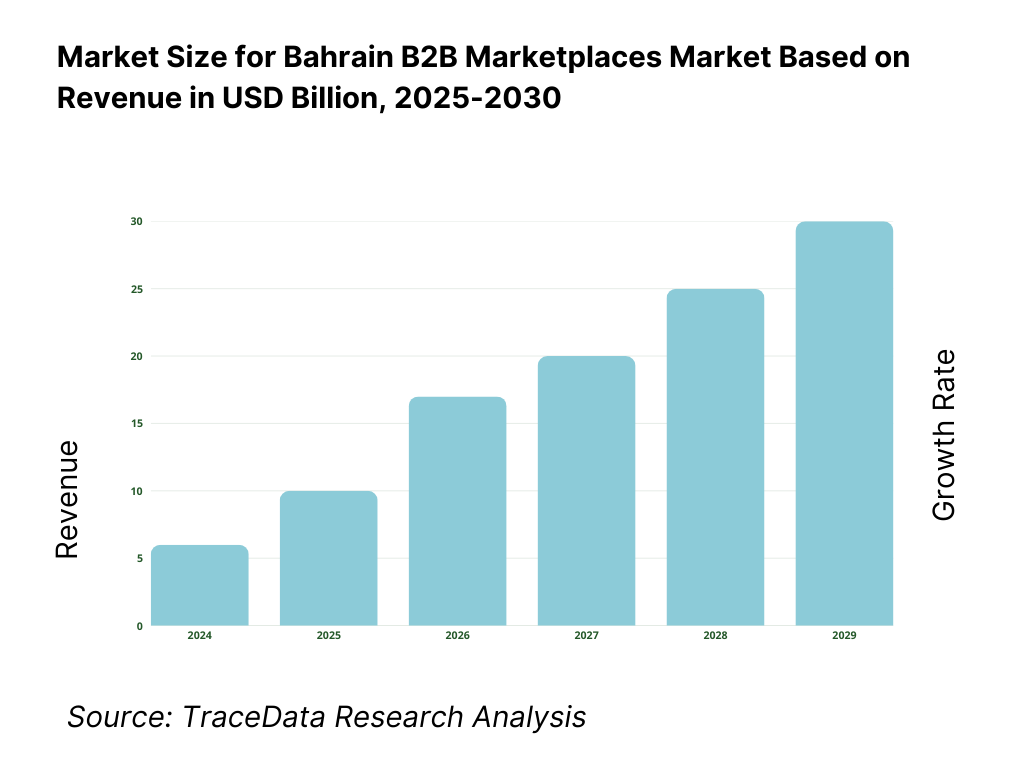
Bahrain B2B Marketplaces Market Segmentation
By Buyer Industry
Industrial & Manufacturing
Construction & MEP
HORECA & FMCG
Healthcare & Pharma
Government & Public Sector
By Marketplace Model
Vertical Marketplaces
Horizontal Marketplaces
B2G Tender Portals
By Buyer Size
Large Enterprises
Mid-Market Firms
SMEs
Micro-SMEs
By Payment Method
Bank Transfers
BenefitPay & Wallets
Cards
BNPL / Trade Credit
e-Cheques
By Fulfillment Mode
Local Warehousing
3PL & Logistics Hubs
Cross-Border (Sea) via Khalifa Bin Salman Port
Cross-Border (Air) via Bahrain International Airport cargo hub
Drop-Shipping
Players Mentioned in the Report:
Tradeling
Alibaba.com (servicing Bahrain)
TradeKey Bahrain
ExportHub Bahrain
MawadOnline
SupplyVan
JomlahBazar
Aumet
Retailo
DUBUY.com
Sary / SILQ
Plant & Equipment
Bahrain Tender Board e-Tendering
Talabat (Grocery/FMCG vertical)
Local Distributor Digital Platforms
Key Target Audience
Corporate Procurement Heads (Industrial, Construction, FMCG, Healthcare)
Chief Digital Officers of B2B Marketplace Operators
Logistics & Supply Chain Directors (3PLs, Free-Zone Operators)
Fintech Leaders (Open Banking, Payment Platforms)
Government & Regulatory Bodies
Investments and Venture Capitalist Firms
Private Equity Investors
Strategy & Expansion Teams of Cross-Border Trade Firms
Time Period:
Historical Period: 2019-2024
Base Year: 2025
- Forecast Period: 2025-2030
Report Coverage
Choose individual sections to purchase. Mix and match as you like.
- -
- -
- $100
4.1. Marketplace Delivery Model Analysis-Vertical, Horizontal, Cross-Border, B2G Tender Portals (Margins, Preference, Strengths & Weaknesses)
4.2. Revenue Streams for Bahrain B2B Marketplaces (Commission, Subscription, Advertising, Logistics Fees, Credit Services)
4.3. Business Model Canvas for Bahrain B2B Marketplaces
$2505.1. Local Sellers vs. Cross-Border Sellers
5.2. Investment Models in Bahrain B2B Marketplaces (VC, PE, Sovereign Fund)
5.3. Comparative Analysis of Seller Onboarding & Buyer Acquisition (Private Platforms vs. Government e-Tendering)
5.4. Procurement Budget Allocation by Buyer Size, 2024
$150- $100
- $200
8.1. Gross Merchandise Value (GMV) & Marketplace Revenues, 2019-2024
$3009.1. By Marketplace Structure (Vertical, Horizontal, B2G Portals), 2023-2024P
9.2. By Buyer Industry (Industrial, Construction, HORECA/FMCG, Healthcare, Public Sector), 2023-2024P
9.2.1. By Type of Industrial Procurement, 2023-2024P
9.2.2. By Type of Construction Procurement, 2023-2024P
9.2.3. By Type of Healthcare Procurement, 2023-2024P
9.2.4. By Type of FMCG Procurement, 2023-2024P
9.3. By Buyer Size (Large Enterprises, Mid-Market, SMEs, Micro-SMEs), 2023-2024P
9.4. By Payment Method (Bank Transfer, BenefitPay, Cards, BNPL, e-Cheque), 2023-2024P
9.5. By Fulfillment Mode (Local Warehousing, 3PL, Cross-Border Sea, Cross-Border Air, Drop-Shipping), 2023-2024P
9.6. By Region (Capital, Muharraq, Northern, Southern), 2023-2024P
$40010.1. Corporate Buyer Landscape and Cohort Analysis
10.2. Procurement Decision-Making Process
10.3. ROI and Value-Added Services Analysis
10.4. Gap Analysis Framework
$50011.1. Trends and Developments for Bahrain B2B Marketplaces Market
11.2. Growth Drivers for Bahrain B2B Marketplaces Market
11.3. SWOT Analysis for Bahrain B2B Marketplaces Market
11.4. Issues and Challenges for Bahrain B2B Marketplaces Market
11.5. Government Regulations for Bahrain B2B Marketplaces Market
$20012.1. Market Size and Future Potential, 2019-2030
12.2. Business Models and Revenue Streams
12.3. Delivery Models and Category Coverage
12.4. Cross-Comparison of Leading B2B Marketplaces (Company Overview, Funding, Revenues, GMV, Buyer Base, Seller Base, Take-Rate, Categories, Payment Integration, Logistics SLA, Compliance Readiness, Recent Developments)
$500- $250
- $150
15.1. Market Share of Key Players in Bahrain B2B Marketplaces, 2024
15.2. Benchmark of Key Competitors (Company Overview, USP, Business Strategies, Business Model, Revenues, Buyer Base, Seller Base, Take-Rate, Technology Stack, Logistics & Payments Integration, Strategic Tie-Ups, Marketing Strategy, Recent Developments)
15.3. Operating Model Analysis Framework
15.4. Gartner Magic Quadrant for B2B Marketplaces in MENA
15.5. Bowmans Strategic Clock for Competitive Advantage
$75016.1. GMV and Revenues, 2025-2030
$30017.1. By Marketplace Structure (Vertical, Horizontal, B2G Portals), 2025-2030
17.2. By Buyer Industry (Industrial, Construction, HORECA/FMCG, Healthcare, Public Sector), 2025-2030
17.2.1. By Type of Industrial Procurement, 2025-2030
17.2.2. By Type of Construction Procurement, 2025-2030
17.2.3. By Type of Healthcare Procurement, 2025-2030
17.2.4. By Type of FMCG Procurement, 2025-2030
17.3. By Buyer Size (Large Enterprises, Mid-Market, SMEs, Micro-SMEs), 2025-2030
17.4. By Payment Method (Bank Transfer, BenefitPay, Cards, BNPL, e-Cheque), 2025-2030
17.5. By Fulfillment Mode (Local Warehousing, 3PL, Cross-Border Sea, Cross-Border Air, Drop-Shipping), 2025-2030
17.6. By Region (Capital, Muharraq, Northern, Southern), 2025-2030
$400- $250
- $250
Research Methodology
Step 1: Ecosystem Creation
We begin by mapping the complete ecosystem of the Bahrain B2B Marketplaces Market, identifying both demand-side entities (SMEs, large enterprises, public sector procurers, and sectoral buyers such as industrial, construction, FMCG, and healthcare) and supply-side entities (marketplace operators, distributors, importers, wholesalers, logistics providers, fintech/payment platforms, and regulators like the Tender Board and NBR). From this mapping, we shortlist 5–6 leading marketplace operators active in Bahrain, based on parameters including financial strength, cross-border reach, active seller/buyer base, and category depth. Sourcing is conducted through government portals, trade registries, industry articles, and proprietary databases, consolidating ecosystem-level intelligence.
Step 2: Desk Research
An extensive desk research phase is carried out by referencing multiple secondary and proprietary databases. This enables us to aggregate market-level insights on transaction flows, number of active platforms, registered sellers, payment adoption (BenefitPay, bank transfers, BNPL), logistics infrastructure, and compliance frameworks (VAT, PDPL, e-invoicing readiness). We examine company-level data including press releases, audited statements, and strategic announcements to capture marketplace growth trajectories. This desk analysis builds the foundational understanding of Bahrain’s B2B marketplaces, integrating financial, operational, and policy-driven variables.
Step 3: Primary Research
We conduct structured in-depth interviews with C-level executives of Bahrain-based and regional marketplace operators, SMEs using these platforms, logistics firms, fintech enablers, and regulators. These interviews serve to validate statistical data, test market hypotheses, and generate insights into procurement cycles, onboarding frictions, fee models, and cross-border trade dynamics. A bottom-up approach is applied to quantify revenues and transaction contributions at the company level, aggregated to market totals. As part of validation, our team undertakes disguised interviews by approaching firms as potential clients, allowing us to corroborate operational, pricing, and compliance details shared by stakeholders.
Step 4: Sanity Check
Finally, both bottom-up and top-down market modeling exercises are performed. The bottom-up validation integrates platform transaction data, while the top-down validation aligns results with macroeconomic indicators such as Bahrain’s non-oil GDP, trade balance, and service sector contributions. This dual approach ensures accuracy, consistency, and sanity of the overall findings for the Bahrain B2B Marketplaces Market.
FAQs
01 What is the Potential for the Bahrain B2B Marketplaces Market?
The Bahrain B2B Marketplaces Market holds substantial potential, supported by the country’s position as a strategic logistics and trade hub in the GCC. Bahrain’s economy, with a nominal GDP of USD 47.8 billion and strong services and industrial sectors, underpins significant procurement demand across industries. The rapid adoption of digital payments such as BenefitPay, integration of open banking APIs, and nationwide internet penetration of 100% create the foundation for B2B platforms to scale. With government-led initiatives like e-tendering and e-invoicing, the market’s potential lies in digitizing procurement for both SMEs and public-sector entities.
02 Who are the Key Players in the Bahrain B2B Marketplaces Market?
The Bahrain B2B Marketplaces Market features several regional and international players, including Tradeling, Alibaba.com, and TradeKey Bahrain, which dominate due to their large buyer networks and extensive supplier bases. Specialized platforms such as MawadOnline (construction materials), Aumet (healthcare and pharmaceuticals), and Retailo (FMCG distribution) provide sector-specific solutions tailored to Bahrain’s procurement ecosystem. Other notable platforms include SupplyVan, JomlahBazar, DUBUY.com by DP World, and the Bahrain Tender Board e-Portal, each contributing to the market’s competitive landscape with differentiated offerings in categories, compliance, and logistics support.
03 What are the Growth Drivers for the Bahrain B2B Marketplaces Market?
The primary growth drivers include Bahrain’s strong trade orientation, with exports and imports together accounting for over 158% of GDP, creating significant demand for cross-border procurement solutions. Digital readiness is another driver, with 1.48 million internet users and 2.1 million mobile connections, ensuring accessibility of online marketplaces. Additionally, government digitization initiatives such as the Bahrain Tender Board e-Procurement platform, NBR’s VAT compliance systems, and planned e-invoicing frameworks further accelerate adoption. Together, these drivers reinforce Bahrain’s positioning as a digital-first marketplace hub for both domestic and international trade.
04 What are the Challenges in the Bahrain B2B Marketplaces Market?
The Bahrain B2B Marketplaces Market faces key challenges, including the country’s public debt burden of 123% of GDP, which constrains fiscal flexibility and may affect SME liquidity and marketplace adoption. Heavy reliance on petroleum exports—accounting for 60% of government revenues—makes procurement cycles vulnerable to commodity price volatility, impacting demand across industrial and construction verticals. Furthermore, regulatory compliance challenges related to PDPL (Personal Data Protection Law), VAT, and future e-invoicing requirements require significant investment by marketplaces to remain fully compliant. These structural challenges present hurdles to sustained, large-scale growth.